23 Unmissable Things to Do on the Big Island, Hawaii
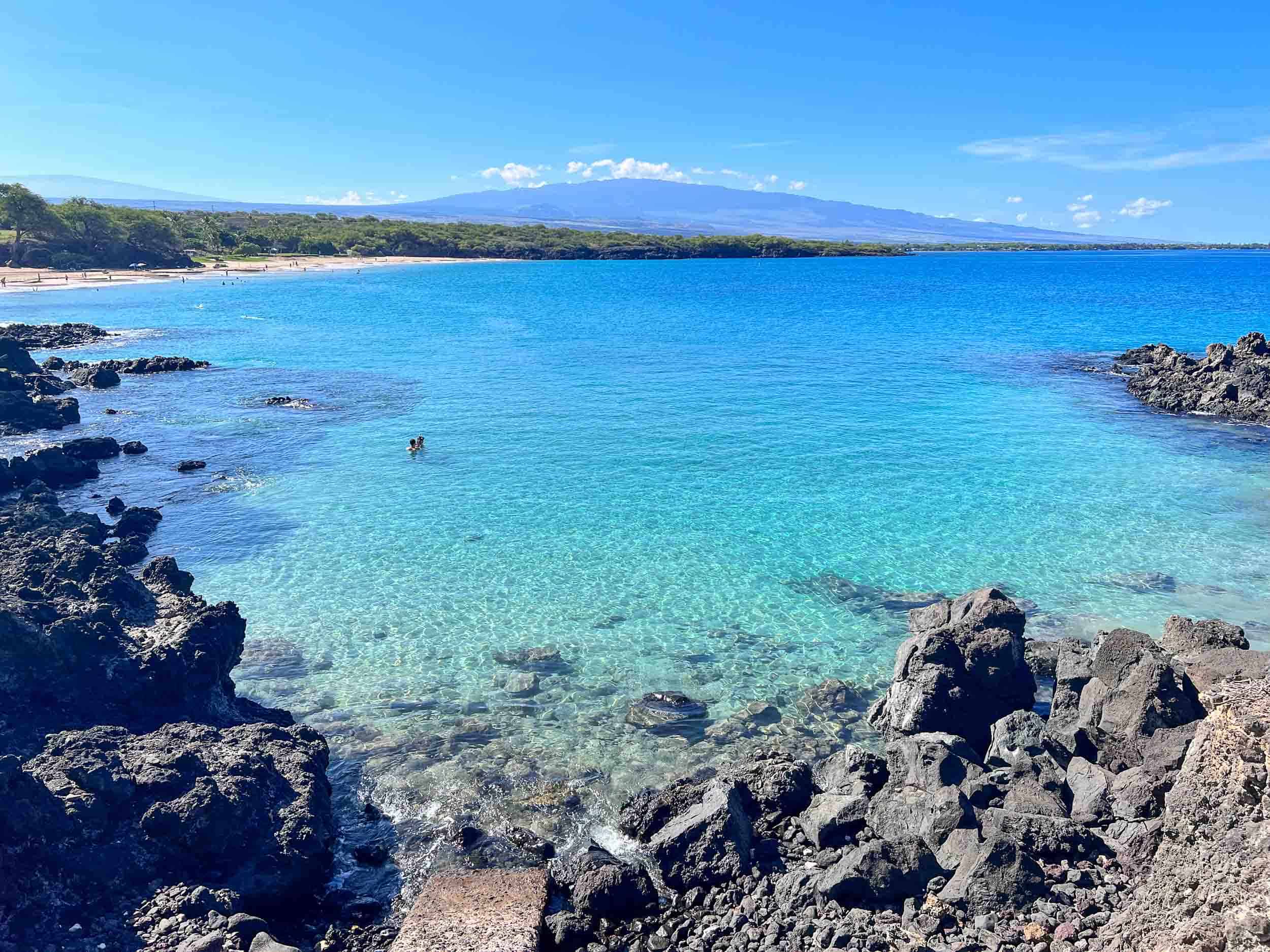
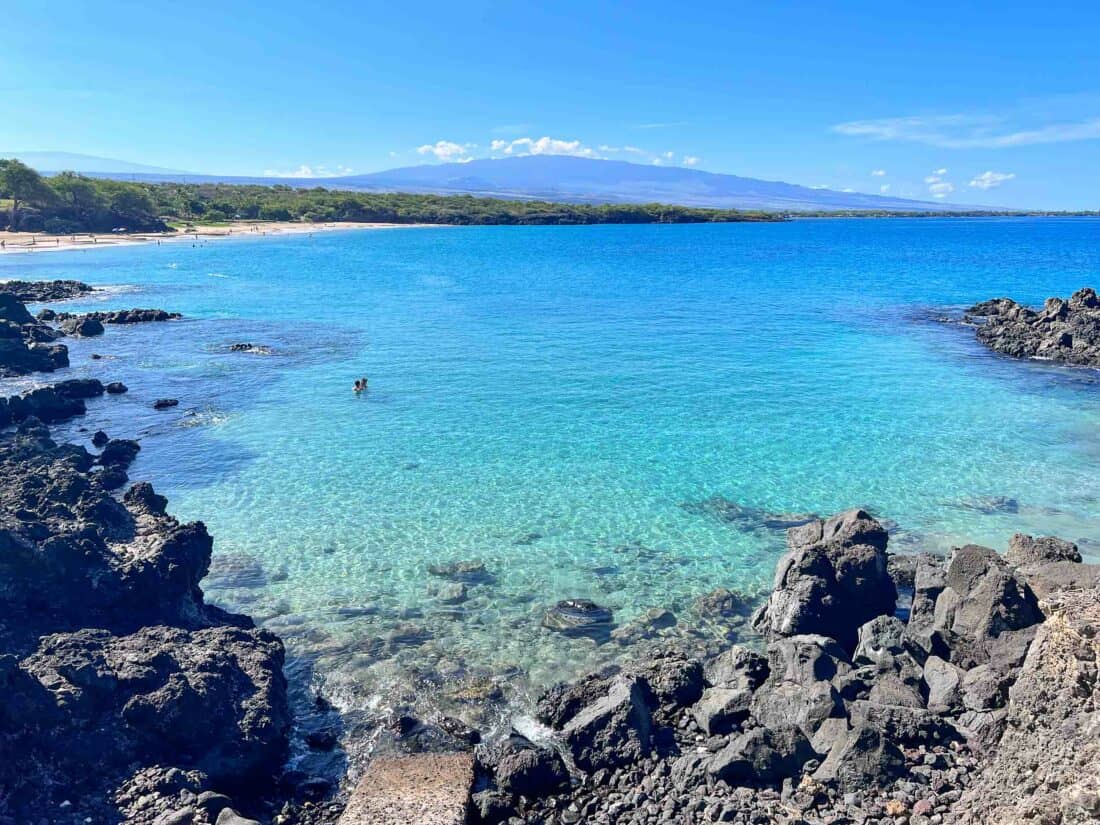
The Big Island feels different from the other Hawaiian islands. It’s larger and younger with incredibly diverse landscapes.
From the stark black lava fields and white sand beaches on the west coast to the rolling ranch land and dramatic valleys of the north to the lush rainforest and waterfalls of the east.
Wherever you are on the island, the volcanoes dominate the view and the chance to see an active eruption is one of the highlights.
Aside from watching lava spewing and hiking into volcanic craters, there are so many amazing things to do on the Big Island.
Our absolute favourite activity was a magical night snorkel with giant manta rays—do not miss it! We also did some excellent snorkelling, relaxed on white and black sand beaches, paddled an outrigger canoe, learnt about Hawaiian history, and so much more.
In this post, we share our top picks for what to do on the Big Island, plus tips on where to stay and a map with all these recommendations.
Contents- Best Place to Stay for These Big Island Activities
- Big Island Must Dos: Our Top 5 Picks
- Best Things to Do in Big Island Hawaii: Kona
- Best Things to Do on the Big Island: Kohala Coast
- Top Things to Do in Big Island: Hilo and Volcano
- Big Island Activities Map
- On Our Big Island Bucket List for Next Time
- More Hawaii Posts
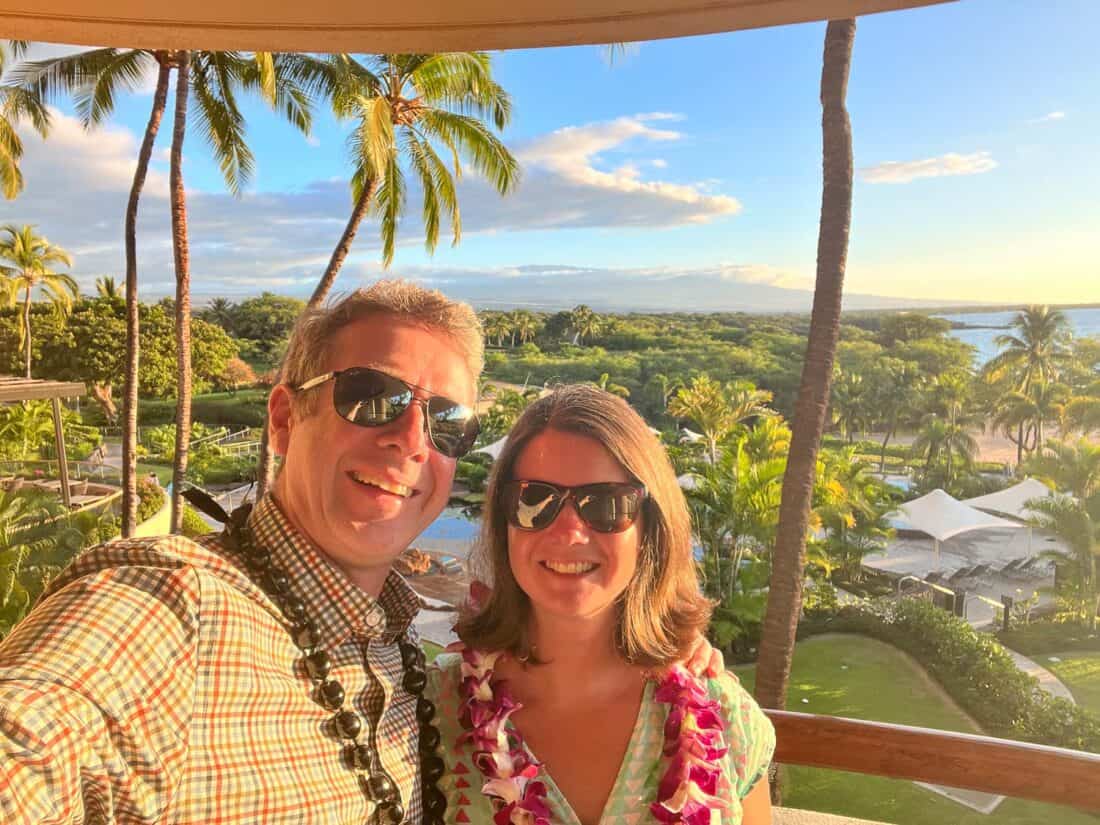 Simon and I at the beautiful Westin Hapuna Beach Resort
Simon and I at the beautiful Westin Hapuna Beach Resort
As the name suggests, the Big Island (officially called Hawaii) is the largest Hawaiian island, and it’s more difficult to explore the whole island from one base.
It’s worth considering dividing your time between the west coast and either Hilo or Volcano in the east.
We split our stay between Waikoloa, a resort area on the Kohala Coast (west coast) and Volcano village in the east.
To save travel time, we flew into Kona Airport and out of Hilo Airport. You’ll definitely want to rent a car to explore all these Big Island attractions.
Kohala Coast
We spent most of our time in this two-bedroom Vrbo condo in the Fairway Villas complex. It was a little dated but well-equipped, and we enjoyed being able to cook and having more space than a hotel room (it’s more affordable too).
It was within walking distance of A-Bay beach and various shops and restaurants.
We also splurged on a night at the Westin Hapuna Beach Resort. The rooms were nothing special for the price, but the grounds are stunning, and the location right on Hapuna Beach is perfect. It has a more secluded feel than the A-Bay area.
Volcano
We adored this cosy suite in the rainforest of Volcano village, very close to Hawaii Volcanoes National Park. See below for more details.
Big Island Must Dos: Our Top 5 PicksIf you are short on time and can’t make it to all these attractions on the Big Island, here are our absolute favourite experiences:
- Manta ray night snorkel – Magical, awe-inspiring, unmissable! Book your tour in advance here.
- Snorkelling at Kealakekua Bay and Two Step – We saw so many tropical fish.
- Staying in the rainforest in Volcano village – Our cabin in the forest was incredibly relaxing and so different from the rest of Hawaii.
- Kilauea Iki Trail – Hike into a volcanic caldera in Hawaii Volcanoes National Park.
- Relax on Hapuna Beach – This Kohala coast beach is one of the most beautiful on the island.
These Big Island activities take place in the Kona area on the west coast of the island.
The main town is Kailua-Kona (just south of Kona airport), but the most interesting attractions are 20-30 minutes further south around Keauhou and Captain Cook.
1) Night Snorkel with Manta Rays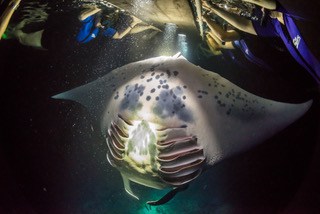
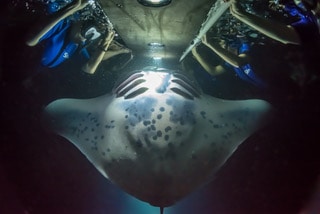
By far our favourite Big Island activity was snorkelling with giant manta rays. It’s one of the most incredible experiences we’ve ever had!
The tours take place at night and involve minimal effort—while you do wear a snorkel, you don’t actually move around, just hold onto a light raft and float on the surface.
The manta rays come to you to feed on the plankton that is attracted to the light.
We couldn’t believe how close the rays got (within inches of us!) or how huge they were—up to 16 feet wing span! We had to stay very still to avoid touching them (which is not allowed as it can harm them).
We saw at least six manta rays and they kept coming back to feast, so we lost track of how many sightings we had.
They swam right below us so we got an up-close look at these strange and majestic creatures, looking right in their eyes and staring into their huge gaping mouths and skeletal gills.
Once they had their fill, they’d flip, roll, and spin beneath us—a graceful ballet that left us in awe.
While we watched, our guides taught us about these fascinating animals. How they live up to 100 years (some of the ones we saw have been around since the 1970s), weigh up to 1000 pounds, and can swim 35 miles per hour.
The mantas have no teeth or stingers, so they can’t hurt humans.
Seriously, do not miss the night swim with manta rays. It’s such a unique, awe-inspiring experience that it’s worth visiting the Big Island just for this.
Details: Many tour operators offer manta swims. We went with Sea Quest, who were fantastic. They were very well organised and provided wetsuits, snorkel gear, flotation noodles (for your legs), and cookies and hot chocolate for afterwards (we really appreciated this!).
They leave from Keauhou Harbor, which is just a five-minute boat ride from the most reliable manta viewing spot. Avoid boat tours from further afield, as it’ll be a cold trip back to base.
Sea Quest manta tours cost $134, take place twice a night (times vary throughout the year), and last 75 minutes. We did the earlier 6.45pm tour. The minimum age is 7, and you must be able to swim and have some snorkelling experience.
If you don’t see any mantas (highly unlikely), you can join another tour for free.
Check availability for the Sea Quest manta swim here.
2) Kayak or Canoe in Kealakekua Bay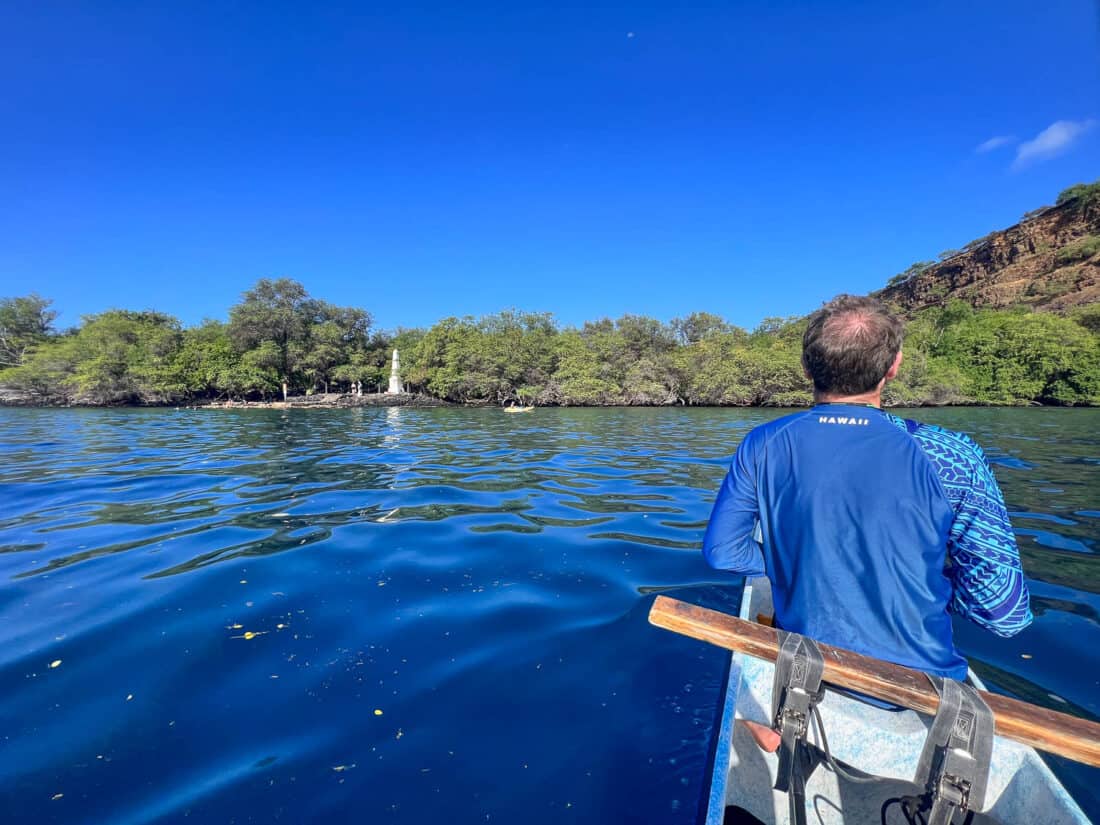
Kealakekua Bay is a protected marine reserve with the best snorkelling on the Big Island (and our personal favourite in all of Hawaii).
It’s also the site of the Captain Cook Monument, which marks where the British explorer was killed in 1779.
Getting to Kealakekua Bay requires some planning. Here are your options:
- Hike – The only free option is a fairly challenging 4-mile hike that takes around 2.5 hours return. The heat put us off this option.
- Boat tour – The easiest choice but likely to be more crowded. This Kona deluxe snorkel tour starts early to avoid the crowds.
- Kayak – You can rent a kayak or take a guided tour. You can only land on the monument if you are on a guided tour with one of three companies (including Adventures in Paradise). To avoid landing, you can tow your kayak while you snorkel. A DIY rental means you can get an early start.
- Outrigger Canoe – This is a less well-known option and the one we did. It’s easier than kayaking and more eco-friendly than a boat tour.
We chose to do this guided outrigger canoe with Ehu and Kai Adventures as we liked the idea of paddling a traditional Hawaiian canoe.
There are a few advantages to the canoe tour. It starts early before the boat tours—it’s a real bonus to enjoy a peaceful snorkel.
The canoes are more stable and easier to paddle than kayaks (and your guide steers)—ideal if you don’t have kayaking experience.
They provide a ladder so it’s easier to get back in after snorkelling, and your guide looks after the canoe while you are in the water, so you don’t have to tow it around like with kayak rentals.
It took us about 20 minutes to paddle across the gloriously clear and calm water in the beautiful bay surrounded by sheer green cliffs. Sadly, we didn’t see any spinner dolphins (a common sight), but the snorkelling was superb with excellent visibility and plentiful coral.
We saw many different fish including an eel, trumpetfish, needlefish, bluefin trevally, reef triggerfish, black triggerfish, longnose butterflyfish, Moorish idol, bullethead parrotfish, spotted boxfish, and lots of yellow tangs.
We were the only people on our trip, so we could spend as long as we wanted in the water. The whole experience was very casual, and our guide was friendly—it felt more like a local showing us around than a commercial tour.
The only downside was that we expected to learn more about the Hawaiian history of the area. While he did tell us about the lava tubes in the cliffs that were used as burial sites for Hawaiian royalty, this portion was brief. The promised refreshments didn’t materialise either, so take some water.
We didn’t really mind, though, and I think it depends on which guide you get—we had the main guide’s nephew.
However you choose to get there, snorkelling at Kealakekua Bay is one of the top things to do in the Big Island.
Details: We booked this Outrigger Canoe Tour, which costs $125 and lasts from 8am – 10.30am. They can provide snorkel gear and dry bags. You can also rent double kayaks for $65.
The tour departs from the end of Kahauloa Rd. You’ll need to find street parking before you get to the end. There are no toilets, but public restrooms are a few minutes away near Kealakekua Bay Boat Ramp.
Be sure to wear reef-safe sunscreen or, even better, a rashguard, as sunscreens bleach the reef. It’s important not to touch or stand on the reef.
3) Snorkel at Two Step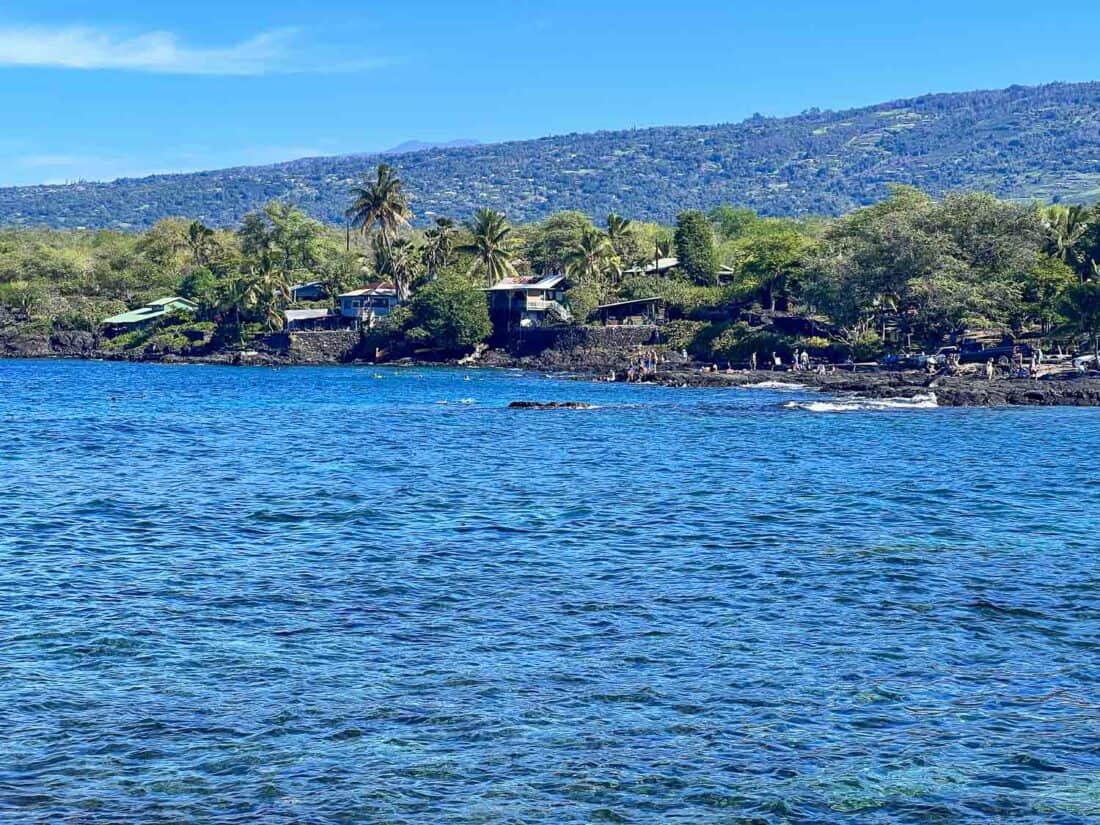
Our second favourite snorkelling spot on the Big Island was Honaunau Bay (more commonly known as Two Step), 10 minutes south of Captain Cook.
It’s also popular, so arrive early to get parking and avoid the crowds. At 7.45am there were a fair number of people around and it only got busier.
Access to the water is from two steps carved into the lava rock (just watch where everyone is getting in). Water shoes could help but we managed without.
We saw a wide range of tropical fish and enjoyed the beautiful underwater landscape that felt more epic than Kealakekua with some big drop-offs.
Details: Snorkelling at Two Step is free, but you’ll need to bring your own snorkel gear. We rented ours for a week from Snorkel Bob’s, which has branches in Kona and Waikoloa.
It’s next to Puʻuhonua o Hōnaunau National Historical Park (which we visited after snorkelling). Before entering the park, turn right onto the one-way road that leads to Two Step.
There is limited free parking (we got a spot), $5 parking across the road, or park back on the main road. There are a few portable toilets but no other facilities.
If you’d rather take a boat tour that combines Two Step and Kealakekua Bay, check out this early morning Kona deluxe snorkel tour.
4) Learn Hawaiian History at Puʻuhonua o Hōnaunau National Historical Park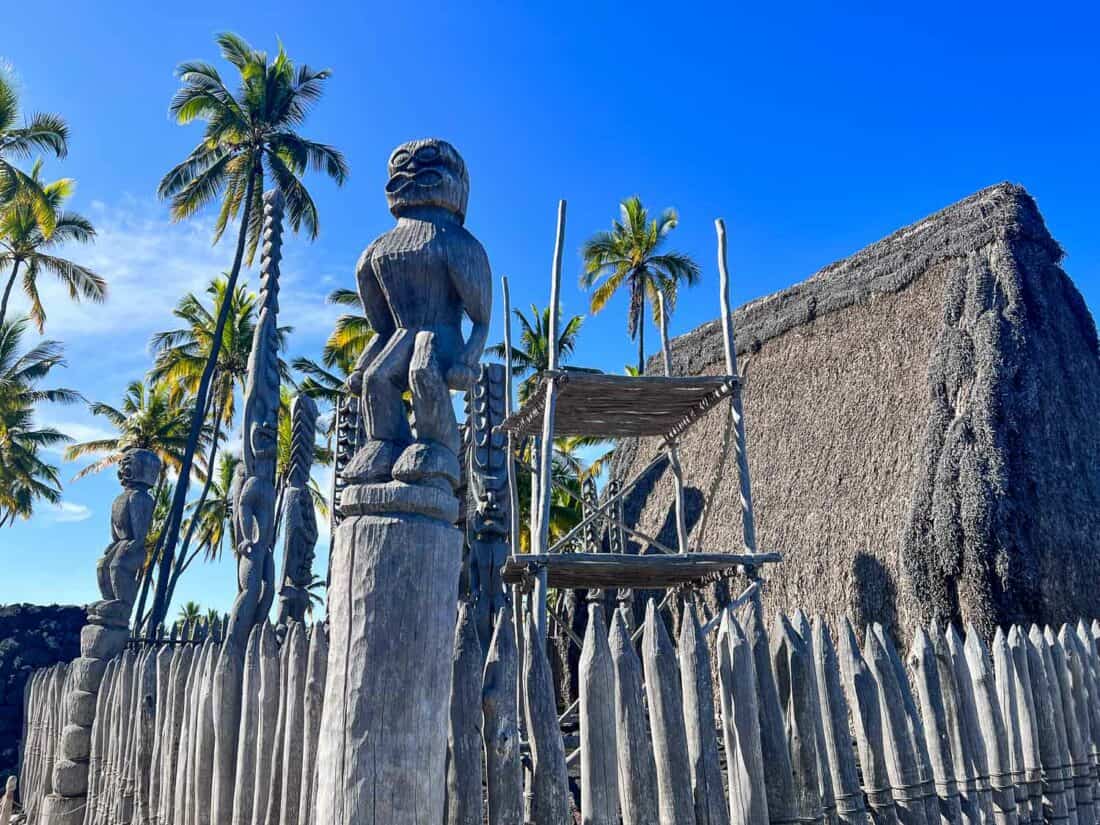
Next to Two Step is Puʻuhonua o Hōnaunau National Historical Park, one of the best places to visit on the Big Island to learn about Hawaiian history and culture.
The site includes royal grounds and Puʻuhonua, a place of refuge in ancient Hawaii for those who broke kapu (sacred laws). Violators would usually be punished by death, but if they managed to get here across rough ocean and sharp lava, they found a safe haven.
Pick up a park map and follow the 0.5-mile self-guided trail to the most important cultural sites in this beautiful coastal park.
The Royal Grounds gives a sense of traditional Hawaiian villages. It was a centre of power only open to aliʻi (royal chiefs) and those who served them.
You can see the Hale o Keawe Temple, which housed the bones of the aliʻi, a canoe house, fishponds, and even games like kōnane, which is played with small stones on a board.
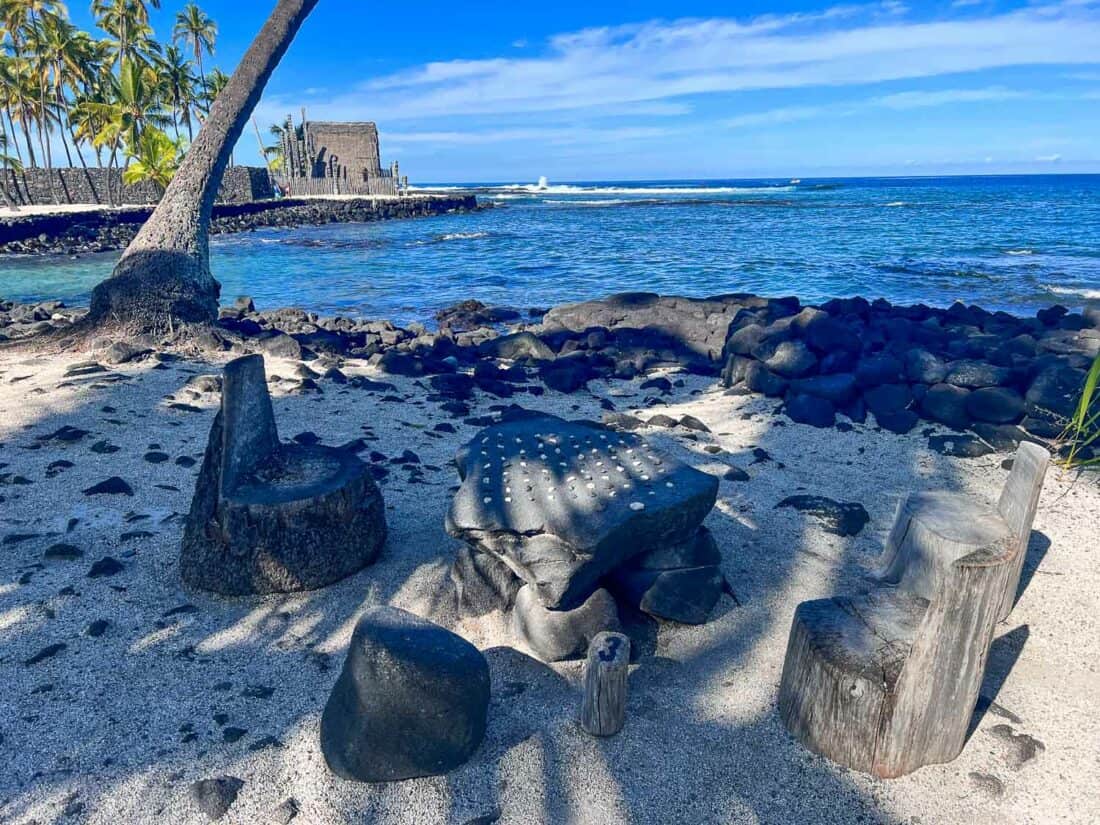
The Great Wall, a huge lava barrier, separates the Royal Grounds and Puʻuhonua sanctuary.
As this is a sacred site, no snorkelling or swimming is allowed. Head to Two Step next door for that. Food is only allowed in the dedicated picnic area.
Details: Puʻuhonua o Hōnaunau is a US National Historical Park managed by the NPS. If you have an America the Beautiful annual pass, you can use it here. Otherwise, it costs $20 per vehicle.
It’s open from 8.15am until sunset every day except federal holidays.
5) Walk the 1871 Trail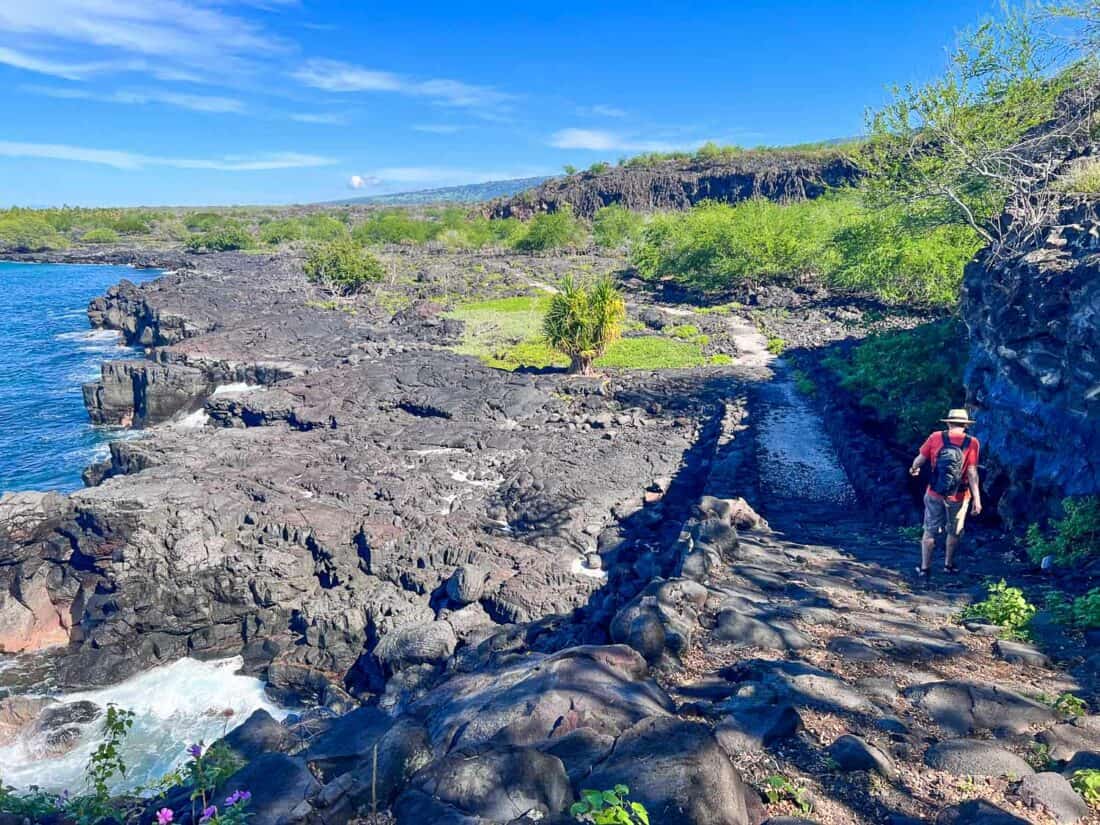
The 1871 hiking trail is part of Puʻuhonua o Hōnaunau and was once used by Hawaiians to get around the island.
The two-mile round-trip walk takes you from Honaunau to Ki’ilae, an abandoned fishing village.
It’s a rugged trail along coastal..
* This article was originally published here
Comments
Post a Comment